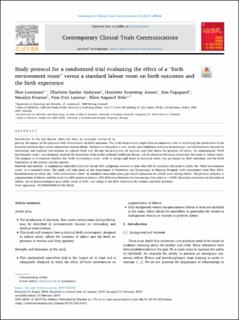| dc.contributor.author | Lorentzen, Iben | |
| dc.contributor.author | Andersen, Charlotte Sander | |
| dc.contributor.author | Jensen, Henriette Svenstrup | |
| dc.contributor.author | Fogsgaard, Ann | |
| dc.contributor.author | Foureur, Maralyn | |
| dc.contributor.author | Lauszus, Finn Friis | |
| dc.contributor.author | Nøhr, Ellen Aagaard | |
| dc.date.accessioned | 2020-04-06T13:18:33Z | |
| dc.date.available | 2020-04-06T13:18:33Z | |
| dc.date.created | 2019-10-18T12:06:45Z | |
| dc.date.issued | 2019 | |
| dc.identifier.citation | Lorentzen, I., Andersen, C. S., Jensen, H. S., Fogsgaard, A., Foureur, M., Lauszus, F. F., & Nohr, E. A. (2019). Study protocol for a randomised trial evaluating the effect of a “birth environment room” versus a standard labour room on birth outcomes and the birth experience. Contemporary Clinical Trials Communications, 14, 100336. | en_US |
| dc.identifier.issn | 2451-8654 | |
| dc.identifier.uri | https://hdl.handle.net/11250/2650515 | |
| dc.description.abstract | Introduction
In the last decade, there has been an increased interest in exploring the impact of the physical birth environment on birth outcomes. The birth environment might have an important role in facilitating the production of the hormone oxytocin that causes contractions during labour. Oxytocin is released in a safe, secure and confidence-inducing environment, and environments focused on technology and medical interventions to achieve birth may disrupt the production of oxytocin and slow down the progress of labour. An experimental “birth environment room” was designed, inspired by knowledge from evidence-based healthcare design, which advocates bringing nature into the room to reduce stress. The purpose is to examine whether the ‘birth environment room’, with its design and decor to minimise stress, has an impact on birth outcomes and the birth experience of the woman and her partner.
Materials and methods
A randomised controlled trial will recruit 680 nulliparous women at term who will be randomly allocated to either the “birth environment room” or a standard room. The study will take place at the Department of Obstetrics and Gynecology at Herning Hospital, with recruitment from May 2015. Randomisation to either the “birth environment room” or standard room takes place just before admission to a birth room during labour. The primary outcome is augmentation of labour, and the study has 80% power to detect a 10% difference between the two groups (two-sided α = 0.05). Secondary outcomes are duration of labour, use of pharmacological pain relief, mode of birth, and rating of the birth experience by women and their partners. | en_US |
| dc.language.iso | eng | en_US |
| dc.rights | Attribution-NonCommercial-NoDerivatives 4.0 Internasjonal | * |
| dc.rights.uri | http://creativecommons.org/licenses/by-nc-nd/4.0/deed.no | * |
| dc.title | Study protocol for a randomised trial evaluating the effect of a "birth environment room" versus a standard labour room on birth outcomes and the birth experience | en_US |
| dc.type | Peer reviewed | en_US |
| dc.type | Journal article | en_US |
| dc.description.version | publishedVersion | en_US |
| dc.rights.holder | © 2019 The Authors | en_US |
| dc.source.volume | 14 | en_US |
| dc.source.journal | Contemporary Clinical Trials Communications | en_US |
| dc.identifier.doi | 10.1016/j.conctc.2019.100336 | |
| dc.identifier.cristin | 1738380 | |
| cristin.ispublished | true | |
| cristin.fulltext | original | |
| cristin.qualitycode | 1 | |

